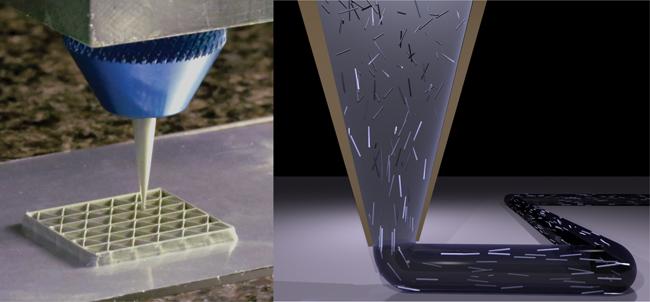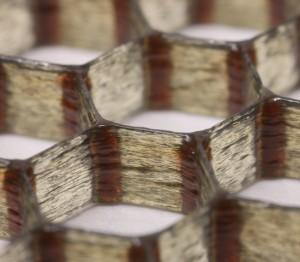3D printing processes have been undertaken using materials such as thermo plastics and UV-curable resins, but now materials scientists from Harvard’s School of Engineering and Applied Sciences have teamed up with the Wyss Institute for Biologically Inspired Engineering to create a printable epoxy-based thermosetting resin. These epoxies allow for the printing of materials to be used as structural components in lightweight architecture. These new 3D inks are composed of epoxy resins combined with nanoclay platelets for enhanced viscosity and a dimethyl methylphosphonate compound. To this mixture two fillers are added, silicon carbine and carbon fibers.
The directionality of those fillers in the ink controls the versatility and strength of the printed material. This particular mixture creates a composite that is adjustable in terms of strength and toughness and that is approximately 200% stronger than the best printed polymer composites currently available. The description of the research was published in the article “3D-Printing of Lightweight Cellular Composites” in an issue of Advanced Materials co-authored by Brett Compton and Jennifer Lewis.
 Lorna Gibson, professor of materials science and mechanical engineering at MIT explained the significance of the research:
Lorna Gibson, professor of materials science and mechanical engineering at MIT explained the significance of the research:
“This paper demonstrates, for the first time, 3D printing of honeycombs with fiber-reinforced cell walls. Of particular significance is the way that the fibers can be aligned, through control of the fiber aspect ration – the length relative to the diameter – and the nozzle diameter. This marks an important step forward in designing engineering materials that mimic wood.”
Why would it be important to be able to mimic wood in this way? After all, we already have wood, right?
A primary potential application for this ink is in the creation of structural honeycomb for use inside the blades of wind turbines. Currently, the insides of these blades are made using sandwiched construction materials, one of which is balsa wood. While balsa is a fast-growing tree that has been identified as a rapidly renewable resource, it does have grain variations that can make it difficult to make it meet the precise performance requirements set for such products. In addition, balsa wood is relatively expensive and as the length of the blades used in these wind turbines increases, even now there are some nearing 250 feet in length, the cost and need for precision grows as well. Using this ink and 3D extrusion printing techniques, the researchers have been able to create cellular composite materials that actually improve on balsa wood.
It’s not just wind turbines that may benefit from this new ink, as fuel efficiency requirements in the automotive industry have become stricter, a strong lightweight material such as this may be just what designers need to help their cars these requirements. Compton sees an exciting future made possible with this epoxy:
“As we gain additional levels of control in filler alignment and learn how to better integrate that orientation into component design, we can further optimize component design and improve materials efficiency. Eventually, we will be able to use 3D printing technology to change the degree of fiber filler alignment and local composition on the fly.”
 Future research plans for the team include exploring thermosetting resins that have precisely aligned and blended fillers as potential materials for both their structural and conductive capabilities. What other uses could such a material have? Discuss this story in the 3D printed epoxy composite forum thread on 3DPB.com.
Future research plans for the team include exploring thermosetting resins that have precisely aligned and blended fillers as potential materials for both their structural and conductive capabilities. What other uses could such a material have? Discuss this story in the 3D printed epoxy composite forum thread on 3DPB.com.
Subscribe to Our Email Newsletter
Stay up-to-date on all the latest news from the 3D printing industry and receive information and offers from third party vendors.
You May Also Like
Creality Begins Selling HALOT-MAGE S: Setting New Standards in Precision 3D Printing
Creality, a leading innovator in consumer-grade 3D printing technology, proudly introduces the HALOT-MAGE S, the latest breakthrough in high-resolution 3D printing. With its cutting-edge features and user-centric design, the HALOT-MAGE...
Farsoon Showcases Comprehensive 3D Printing Solutions, Automation, and More at TCT Asia
This year’s TCT Asia event showcased just how much the Asian additive manufacturing (AM) market has grown, with Eplus3D’s 64-laser metal 3D printer alone acting as a synecdoche for China’s...
Creality Launches Ender-3 V3 Plus: Bigger CoreXZ for Unprecedented Performance
Embracing a journey of innovation and excellence, Creality’s Ender-3 series has established a distinguished path in the field of 3D printing. From the entry-level Ender-3 V3 SE to the feature-rich...
Laser Wars: Eplus3D Unveils Metal 3D Printer with up to 64 Lasers
Now that the laser wars in the powder bed fusion (PBF) space have, for the most part, moved to China, original equipment manufacturers (OEMs) there are in fierce competition. Eplus3D...

































